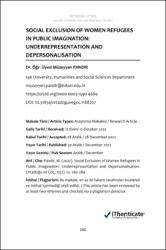Social exclusion of women refugees in public imagination: underrepresentation and depersonalisation
Künye
Pandır, M. (2022). Social exclusion of women refugees in public imagination: underrepresentation and depersonalisation. Ortadoğu ve Göç, 12(2), 260-284. doi:10.31834/ortadoguvegoc.1188207Özet
This paper studies the news images of Syrian women refugees and the representational practices employed in them to question how these portraying practices position women refugees, and how they actually act as ways of socially excluding them in the host community. Analysed are the newspaper photographs of Syrian women refugees published in top-selling four Turkish newspapers in 2015. Using a content analysis fed by visual analysis, the ways of visually portraying women refugees is studied by investigating the representational elements and practices in the images, which are subject, theme, camera distance, camera angle and location. The findings reveal that Syrian women refugees are underrepresented and in the rare cases of their appearance, the way they are portrayed position them as distant, passive and depersonalised subjects as part of the masses. The underrepresentation and depersonalisation of women refugees, who are among the vulnerable women group 1) erase the individual life stories and varied lived experiences of women refugees from public imagination and deny the female refugee agency, 2) prevent the emergence of the public talk on the women refugee problems, which in turn 3) prevent the formation of a social understanding and empathy towards women refugees. Thus, it is argued that the ways in which Syrian women refugees are portrayed in the media act as barriers for their social inclusion. Bu çalışma, Suriyeli kadın mülteci haber görsellerini ve görsellerde kullanılan temsil pratiklerinin kadın mültecileri nasıl konumlandırdığını, ve bu temsil pratiklerinin kadın mültecilerin toplumsal dışlanmasına yönelik işleyişlerini ele almaktadır. Çalışmada, 2015 yılında en çok okunan dört Türk gazetesinde yayınlanan Suriyeli kadın mülteci fotoğrafları incelenmektedir. İçerik analizi ve görsel analiz yöntemleri kullanılarak görsellerdeki temsil öğeleri - özne, tema, kamera uzaklığı, kamera açısı, yer/mekan - incelenmiş ve kadın mültecilerin görselleştirilme şekilleri ortaya çıkarılmıştır. Çalışmanın bulguları, Suriyeli kadın mültecilerin yetersiz temsil edildiğini ve temsil edildikleri nadir anlarda da temsil edilme şekillerinin onları uzak, pasif, ve kitleler arasında kişiliksizleştirilmiş özneler olarak konumlandırdığını ortaya koymaktadır. Kırılgan kadın grubu içerisinde yer alan kadın mültecilerin yetersiz temsili ve kişiliksizleştirilmesi, 1) kadın mültecilerin bireysel hayat hikayelerini ve çeşitli yaşam deneyimlerini kamunun tahayyülünden silmekte ve kadın mülteci eylemliliğini reddetmekte, 2) kadın mültecilerin karşılaştıkları sorunların kamusal alanda tartışılmasını önlemekte, bunun sonucunda da 3) kadın mültecilere yönelik toplumsal anlayış ve empati oluşumunu engellemektedir. Bu açıdan çalışma, Suriyeli mülteci kadınların temsil şekillerinin toplumsal kabulleri için bir engel teşkil ettiğini savunmaktadır.


















